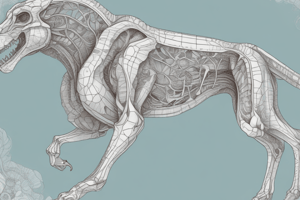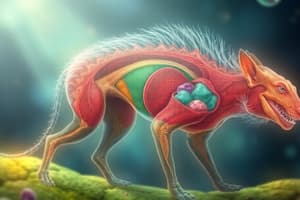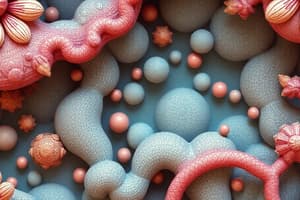Podcast
Questions and Answers
What is the main site for digestion in Cnidaria?
What is the main site for digestion in Cnidaria?
- Endodermal cells
- Mesoglea
- Gastrovascular cavity (correct)
- Ectoderm
Which class of Cnidaria includes solitary or colonial polyps?
Which class of Cnidaria includes solitary or colonial polyps?
- Scyphozoa
- Hydrozoa
- Athecata
- Anthozoa (correct)
Which kingdom do animals belong to?
Which kingdom do animals belong to?
- Animalia (correct)
- Plantae
- Protista
- Fungi
Which class of Cnidaria has the predominant form of medusa in its life cycle?
Which class of Cnidaria has the predominant form of medusa in its life cycle?
Which phylum has radial symmetrical animals?
Which phylum has radial symmetrical animals?
What is the division where a middle layer, mesoderm, is formed between the ectoderm and endoderm of the embryo?
What is the division where a middle layer, mesoderm, is formed between the ectoderm and endoderm of the embryo?
How do respiration and excretion mainly occur in Cnidaria?
How do respiration and excretion mainly occur in Cnidaria?
What is the primary origin of the gonads in Cnidaria?
What is the primary origin of the gonads in Cnidaria?
In which kingdom are tissues more developed and organized into organs and organ systems?
In which kingdom are tissues more developed and organized into organs and organ systems?
Which phylum lacks an internal body cavity between the digestive tract and outer body wall?
Which phylum lacks an internal body cavity between the digestive tract and outer body wall?
Which part of Cnidaria does not have a stomodaeum?
Which part of Cnidaria does not have a stomodaeum?
Which level of organization characterizes multicellular animals in the phylum Cnidaria (Coelenterata)?
Which level of organization characterizes multicellular animals in the phylum Cnidaria (Coelenterata)?
What is the level of organization of sponges?
What is the level of organization of sponges?
Which of the following best describes the body symmetry of sponges?
Which of the following best describes the body symmetry of sponges?
What is the name of the single cavity inside a sponge lined by choanocytes?
What is the name of the single cavity inside a sponge lined by choanocytes?
What gives support to sponges and prevents the collapse of canals and chambers?
What gives support to sponges and prevents the collapse of canals and chambers?
Based on what feature are sponges classified?
Based on what feature are sponges classified?
What is the purpose of ostia in sponges?
What is the purpose of ostia in sponges?
Flashcards are hidden until you start studying
Study Notes
Kingdom Animalia, Sub-kingdom Parazoa, Phylum Porifera (Sponges)
- Sponges are multicellular animals with cellular level of organization.
- Cells do not form tissues and are less specialized.
- Sponges are sessile, aquatic, mostly marine, and few species are freshwater.
- Body is asymmetrical or radially symmetrical.
- Sponges have diverse forms, colors, and sizes, ranging from a few mm to 2 m in diameter.
- Body is perforated by numerous pores (ostia and osculum), canals, and chambers through which water continuously flows.
- There is a single cavity inside the body, called paragastric cavity (spongocoel), lined by choanocytes.
- Internal skeleton is composed of calcareous or siliceous spicules and/or spongin fibers.
- Digestion is partly extracellular and partly intracellular.
- Respiration and excretion occur through simple diffusion through the body surface.
- Simple diffused nervous tissue is present in the form of a nerve net.
- Sensory cells are present with sensory organs in medusa.
- Some colonial forms secrete massive external calcareous skeleton.
Classification of Phylum Cnidaria (Coelenterata)
- Classified into 3 main classes: Hydrozoa, Scyphozoa, and Anthozoa (Actinozoa).
- Class Hydrozoa: Hydra viridis, Obelia sp.
- Class Scyphozoa: Aurelia (Moon jelly fish).
- Class Anthozoa (Actinozoa): Alcyonium, Sea anemone, Stony corals.
Characteristics of Phylum Cnidaria (Coelenterata)
- Multicellular animals with tissue level of organization.
- Body is built up of two layers: outer ectoderm and inner endoderm.
- Bilateral symmetrical animals, except adults of most echinoderms.
- Tissue formation is primitive in lower phyla and more developed in higher groups.
Division of Kingdom Animalia
- Diploblastica: Phylum Cnidaria (Coelentrata).
- Triploblastica: Phyla with a middle layer, or mesoderm, formed in between the ectoderm and endoderm of embryo.
Body Cavity Formation
- Coelomata: Extensive fluid-filled cavity (coelom) completely lined with mesoderm, separating the digestive tract from the outer body wall.
- Pseudocoelomata: Fluid-filled body cavity not completely lined with mesodermal tissue.
- Acoelomata: No internal body cavity, or coelom, in the mesoderm between the digestive tract and the outer body wall.
Studying That Suits You
Use AI to generate personalized quizzes and flashcards to suit your learning preferences.




